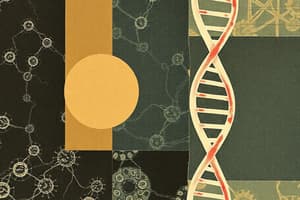Podcast
Questions and Answers
What is the primary function of the mitochondria within a cell?
What is the primary function of the mitochondria within a cell?
- Sorts and packs finished molecules into vesicles.
- Synthesizes lipids and breaks down proteins.
- Produces usable energy through cellular respiration. (correct)
- Creates chemical potential energy through photosynthesis.
Which phase of interphase is primarily concerned with DNA replication?
Which phase of interphase is primarily concerned with DNA replication?
- S phase (correct)
- G2 phase
- M phase
- G1 phase
In plant cells, which structure is responsible for the process of photosynthesis?
In plant cells, which structure is responsible for the process of photosynthesis?
- Nucleus
- Chloroplast (correct)
- Vacuole
- Ribosomes
What is the main role of lysosomes in a cell?
What is the main role of lysosomes in a cell?
Which of the following organelles is directly involved in synthesizing proteins?
Which of the following organelles is directly involved in synthesizing proteins?
Flashcards
Cell membrane
Cell membrane
The outer layer of a cell that controls what enters and exits, acting like a gatekeeper.
Cytoplasm
Cytoplasm
The gel-like substance that fills the cell and suspends its organelles.
Interphase
Interphase
The phase in the cell cycle where the cell prepares for division, including DNA replication.
Mitosis
Mitosis
Signup and view all the flashcards
S phase
S phase
Signup and view all the flashcards
Study Notes
Cell Structure
- Cell Membrane: Outer layer, semi-permeable, controls what enters and exits the cell
- Cytoplasm: Suspends organelles, provides structure
- Ribosomes: Synthesize proteins
- Smooth Endoplasmic Reticulum (SER): Synthesizes lipids, breaks down proteins
- Rough Endoplasmic Reticulum (RER): Transports proteins made by ribosomes
- Golgi Apparatus: Sorts and packs finished molecules into vesicles
- Lysosomes: Uses enzymes to break down molecules
- Mitochondria: Makes usable energy through cellular respiration
- Vacuole: In animal cells, many small vacuoles; in plant cells, one large vacuole for storage
- Nucleus: Protects DNA, stores DNA
- Nuclear Membrane: Controls what goes in and out of the nucleus, protects DNA
- Nucleolus: Creates ribosomes
Cell Cycle & Mitosis
- Interphase: Preparation for cell division
- G1: Growth, nutrients are gathered, new proteins and organelles are produced for cell division
- S: DNA replication, proteins associated with chromosomes are produced
- G2: Final preparation, organelles and structures needed for mitosis are produced. (90% of cell cycle)
- Mitosis: Cell division
Plant & Animal Cells
- Plant Cells: Have cell walls for protection and structure; chloroplasts for photosynthesis
- Animal Cells: Do Not have cell walls; centrioles are present for cell division
Studying That Suits You
Use AI to generate personalized quizzes and flashcards to suit your learning preferences.



